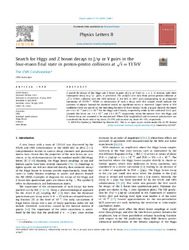Search for Higgs and Z boson decays to J/ψor Ypairs in the four-muon final state in proton-proton collisions at √s=13 TeV
| dc.contributor.author | Sirunyan, A. M. | |
| dc.contributor.author | Işıldak, Bora | |
| dc.date.accessioned | 2020-06-29T09:55:01Z | |
| dc.date.available | 2020-06-29T09:55:01Z | |
| dc.date.issued | 2019-10-10 | |
| dc.identifier.issn | 0370-2693 | en_US |
| dc.identifier.uri | http://hdl.handle.net/10679/6657 | |
| dc.identifier.uri | https://www.sciencedirect.com/science/article/pii/S0370269319305210 | |
| dc.description.abstract | A search for decays of the Higgs and Z boson to pairs of J/ψ or Y(nS) (n = 1, 2, 3) mesons, with their subsequent decay to μ+μ− pairs, is presented. The analysis uses data from proton-proton collisions at s=13TeV, collected with the CMS detector at the LHC in 2017 and corresponding to an integrated luminosity of 37.5fb−1. While an observation of such a decay with this sample would indicate the presence of physics beyond the standard model, no significant excess is observed. Upper limits at 95% confidence level are placed on the branching fractions of these decays. In the J/ψ pair channel, the limits are 1.8×10−3 and 2.2×10−6 for the Higgs and Z boson, respectively, while in the combined Y(nS) pair channel, the limits are 1.4×10−3 and 1.5×10−6, respectively, when the mesons from the Higgs and Z boson decay are assumed to be unpolarized. When fully longitudinal and transverse polarizations are considered the limits reduce by about 22–29% and increase by about 10–13%, respectively. | en_US |
| dc.description.sponsorship | BMBWF and FWF (Austria); FNRS and FWO (Belgium); CNPq, CAPES, FAPERJ, FAPERGS, and FAPESP (Brazil); MES (Bulgaria); CERN; CAS, MOST, and NSFC (China); COLCIENCIAS (Colombia); MSES and CSF (Croatia); RPF (Cyprus); SENESCYT (Ecuador); MoER, ERC IUT, PUT and ERDF (Estonia); Academy of Finland, MEC, and HIP (Finland); CEA and CNRS/IN2P3 (France); BMBF, DFG, and HGF (Germany); GSRT (Greece); NK-FIA (Hungary); DAE and DST (India); IPM (Iran); SFI (Ireland); INFN (Italy); MSIP and NRF (Republic of Korea); MES (Latvia); LAS (Lithuania); MOE and UM (Malaysia); BUAP, CINVESTAV, CONACYT, LNS, SEP, and UASLP-FAI (Mexico); MOS (Montenegro); MBIE (New Zealand); PAEC (Pakistan); MSHE and NSC (Poland); FCT (Portu-gal); JINR (Dubna); MON, ROSATOM, RAS, RFBR, and NRC KI (Rus-sia); MESTD (Serbia); SEIDI, CPAN, PCTI, and FEDER (Spain); MoSTR(Sri Lanka); Swiss Funding Agencies (Switzerland); MST (Taipei); ThEPCenter, IPST, STAR, and NSTDA (Thailand); TUBITAK and TAEK (Turkey); NASU and SFFR (Ukraine); STFC (United Kingdom); DOE and NSF (USA). Individuals have received support from the Marie-Curie pro-gram and the European Research Council and Horizon 2020 Grant, contract Nos. 675440, 752730, and 765710 (European Union); the Leventis Foundation; the A.P. Sloan Foundation; the Alexan-der von Humboldt Foundation; the Belgian Federal Science Pol-icy Office; the Fonds pour la Formation à la Recherche dans l’Industrie et dans l’Agriculture (FRIA-Belgium); the Agentschap voor Innovatie door Wetenschap en Technologie (IWT-Belgium); the F.R.S.-FNRS and FWO (Belgium) under the “Excellence of Sci-ence – EOS” – be.h project n. 30820817; the Beijing Municipal Science & Technology Commission, No. Z181100004218003; the Ministry of Education, Youth and Sports (MEYS) of the Czech Republic; the Lendület (“Momentum”) Program and the János Bolyai Research Scholarship of the Hungarian Academy of Sci-ences, the New National Excellence Program ÚNKP, the NKFIA re-search grants 123842, 123959, 124845, 124850, 125105, 128713, 128786, and 129058 (Hungary); the Council of Science and Indus-trial Research, India; the HOMING PLUS program of the Founda-tion for Polish Science, cofinanced from European Union, Euro-pean Regional Development Fund, the Mobility Plus program of the Ministry of Science and Higher Education, the National Science Center (Poland), contracts Harmonia 2014/14/M/ST2/00428, Opus 2014/13/B/ST2/02543, 2014/15/B/ST2/03998, and 2015/19/B/ST2/02861, Sonata-bis 2012/07/E/ST2/01406; the National Priorities Re-search Program by Qatar National Research Fund; the Programa Estatal de Fomento de la Investigación Científica y Técnica de Ex-celencia María de Maeztu, grant MDM-2015-0509 and the Pro-grama Severo Ochoa del Principado de Asturias; the Thalis and Aristeia programs cofinanced by EU-ESF and the Greek NSRF; the Rachadapisek Sompot Fund for Postdoctoral Fellowship, Chu-lalongkorn University and the Chulalongkorn Academic into Its 2nd Century Project Advancement Project (Thailand); the Welch Foundation, contract C-1845; and the Weston Havens Foundation (USA). | |
| dc.language.iso | eng | en_US |
| dc.publisher | Elsevier | en_US |
| dc.relation.ispartof | Physics Letters B | |
| dc.rights | openAccess | |
| dc.title | Search for Higgs and Z boson decays to J/ψor Ypairs in the four-muon final state in proton-proton collisions at √s=13 TeV | en_US |
| dc.type | Article | en_US |
| dc.description.version | Publisher version | en_US |
| dc.peerreviewed | yes | en_US |
| dc.publicationstatus | Published | en_US |
| dc.contributor.department | Özyeğin University | |
| dc.contributor.authorID | (ORCID 0000-0002-0283-5234 & YÖK ID 124605) Işıldak, Bora | |
| dc.contributor.ozuauthor | Işıldak, Bora | |
| dc.creator | The CMS Collaboration | |
| dc.identifier.volume | 797 | en_US |
| dc.identifier.wos | WOS:000488071200020 | |
| dc.identifier.doi | 10.1016/j.physletb.2019.134811 | en_US |
| dc.subject.keywords | CMS | en_US |
| dc.subject.keywords | Standard model physics | en_US |
| dc.subject.keywords | Higgs boson | en_US |
| dc.subject.keywords | Z boson | en_US |
| dc.subject.keywords | Rare decays | en_US |
| dc.identifier.scopus | SCOPUS:2-s2.0-85070317489 | |
| dc.contributor.authorMale | 1 | |
| dc.relation.publicationcategory | Article - International Refereed Journal - Institution Academic Staff |
Files in this item
This item appears in the following Collection(s)
Share this page



